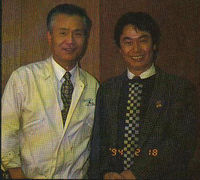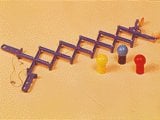Gunpei Yokoi: Difference between revisions
Digibutter (talk | contribs) m (→History) |
(actually, his last job at Nintendo was the Game Boy Pocket.) |
||
| Line 15: | Line 15: | ||
In the 1980s, hoping to capitalize on the rising popularity of electronics as a form of entertainment, Yamauchi came up with a concept for a handheld gaming device. The project was assigned to Yokoi, who spent extensive time developing the device. Yokoi was inspired by a man he saw playing with a calculator on a train. The device that resulted was the Game & Watch. It became a best-seller, and the games sold more than 40 million copies worldwide. Yokoi eventually became the head of the first-party company R&D1, which was responsible for the game ''[[Mario Bros. (game)|Mario Bros.]]''. He would go on to develop the Game Boy and its successors up to the [[Game Boy Advance]] and would add [[Princess Daisy]], [[Wario]], and [[Pit]] (the protagonist of [[wikipedia:Kid Icarus|''Kid Icarus'']]) to Nintendo's game character roster. | In the 1980s, hoping to capitalize on the rising popularity of electronics as a form of entertainment, Yamauchi came up with a concept for a handheld gaming device. The project was assigned to Yokoi, who spent extensive time developing the device. Yokoi was inspired by a man he saw playing with a calculator on a train. The device that resulted was the Game & Watch. It became a best-seller, and the games sold more than 40 million copies worldwide. Yokoi eventually became the head of the first-party company R&D1, which was responsible for the game ''[[Mario Bros. (game)|Mario Bros.]]''. He would go on to develop the Game Boy and its successors up to the [[Game Boy Advance]] and would add [[Princess Daisy]], [[Wario]], and [[Pit]] (the protagonist of [[wikipedia:Kid Icarus|''Kid Icarus'']]) to Nintendo's game character roster. | ||
However, Yokoi's career was not entirely successful. | However, Yokoi's career was not entirely successful. The [Virtual Boy]], received poor reception and was discontinued a year after its release. Following the competion of the [[Game Boy]] Pocket, Yokoi subsequently left Nintendo to form his Koto Laboratory <ref>http://www.koto.co.jp/english/aboutus/index.html</ref>, where he remained until his death in 1997. Two hundred fifty miles northeast of Tokyo, Yokoi was struck by two automobiles while checking his car for damage following a minor fender bender. Word of his death was broadcast worldwide soon after, but this traumatic event did not dampen his legacy. In 2003, Yokoi posthumously received the Lifetime Achievement Award at the Game Developers Choice Awards as an acknowledgement and celebration of his influence in the video game industry. | ||
==Gallery== | ==Gallery== | ||
Revision as of 15:51, August 10, 2014

Gunpei Yokoi (in Japanese: 横井 軍平; September 10, 1941 — October 4, 1997) was one of Nintendo's most famous developers. His repertoire includes a plethora of now-iconic devices, including the Game Boy, the Game & Watch, and the R.O.B. accessory for the Famicom. Aside from hardware, Yokoi also produced Metroid and the Super Mario Land series and created three Nintendo characters: Princess Daisy, Wario, and Pit, though he is most well-known for being mentor to Mario series creator Shigeru Miyamoto. Yokoi also acted as the manager of Nintendo R&D 1 from its creation up to his departure from the company.
History
Born on September 10, 1941, Yokoi was raised in Kyoto, Japan and received an electronics degree from Doshisha University. He began his employment at Nintendo (then a toy company) as a janitor in 1965, though his fortune improved five years later. While looking around Nintendo headquarters, Hiroshi Yamauchi, president of Nintendo at the time, noticed an extending arm toy that Yokoi had made in his spare time called the Ultra Hand. Interested in the product, he told Yokoi to mass-produce it and sell it. The Ultra Hand was a huge commercial success, and Yokoi was upgraded to product developer. He continued his toy production, becoming one of the most well-known figures at Nintendo. He then proceeded to use his experience to tutor Miyamoto on the many skills he had learned.
In the 1980s, hoping to capitalize on the rising popularity of electronics as a form of entertainment, Yamauchi came up with a concept for a handheld gaming device. The project was assigned to Yokoi, who spent extensive time developing the device. Yokoi was inspired by a man he saw playing with a calculator on a train. The device that resulted was the Game & Watch. It became a best-seller, and the games sold more than 40 million copies worldwide. Yokoi eventually became the head of the first-party company R&D1, which was responsible for the game Mario Bros.. He would go on to develop the Game Boy and its successors up to the Game Boy Advance and would add Princess Daisy, Wario, and Pit (the protagonist of Kid Icarus) to Nintendo's game character roster.
However, Yokoi's career was not entirely successful. The [Virtual Boy]], received poor reception and was discontinued a year after its release. Following the competion of the Game Boy Pocket, Yokoi subsequently left Nintendo to form his Koto Laboratory [1], where he remained until his death in 1997. Two hundred fifty miles northeast of Tokyo, Yokoi was struck by two automobiles while checking his car for damage following a minor fender bender. Word of his death was broadcast worldwide soon after, but this traumatic event did not dampen his legacy. In 2003, Yokoi posthumously received the Lifetime Achievement Award at the Game Developers Choice Awards as an acknowledgement and celebration of his influence in the video game industry.
Gallery
- Gunpei Yokoi Farewell Article.png
Magazine article about Gunpei leaving Nintendo.
- Gunpei Yokoi Death Article.png
Magazine article about Gunpei's death in a car crash.
Trivia
- During the credits of Wario Land: Super Mario Land 3 for the Game Boy, his name is spelled as "Gumpei Yokoi".
- The Ultra Hand is seen in Mario Power Tennis for the Nintendo GameCube and Wii as Wario's Defensive Power Shot, known as the Ultra-Hand Return.
- The Ultra Hand makes cameos in the microgames Ultra Hand in WarioWare, Inc.: Mega Microgame$! and Clawing for More in WarioWare: Touched!.
